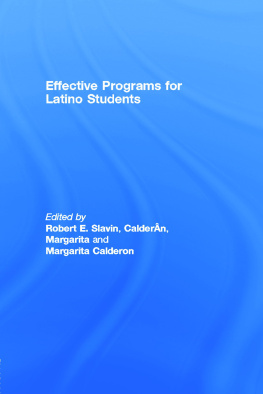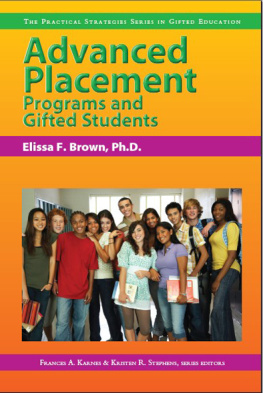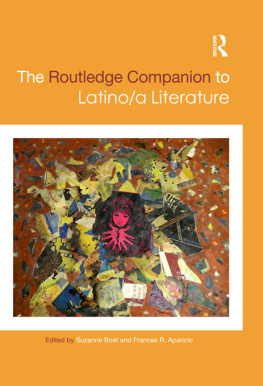Slavin Robert E. - Effective Programs for Latino Students
Here you can read online Slavin Robert E. - Effective Programs for Latino Students full text of the book (entire story) in english for free. Download pdf and epub, get meaning, cover and reviews about this ebook. publisher: Taylor & Francis Group, genre: Home and family. Description of the work, (preface) as well as reviews are available. Best literature library LitArk.com created for fans of good reading and offers a wide selection of genres:
Romance novel
Science fiction
Adventure
Detective
Science
History
Home and family
Prose
Art
Politics
Computer
Non-fiction
Religion
Business
Children
Humor
Choose a favorite category and find really read worthwhile books. Enjoy immersion in the world of imagination, feel the emotions of the characters or learn something new for yourself, make an fascinating discovery.
- Book:Effective Programs for Latino Students
- Author:
- Publisher:Taylor & Francis Group
- Genre:
- Rating:4 / 5
- Favourites:Add to favourites
- Your mark:
- 80
- 1
- 2
- 3
- 4
- 5
Effective Programs for Latino Students: summary, description and annotation
We offer to read an annotation, description, summary or preface (depends on what the author of the book "Effective Programs for Latino Students" wrote himself). If you haven't found the necessary information about the book — write in the comments, we will try to find it.
Effective Programs for Latino Students — read online for free the complete book (whole text) full work
Below is the text of the book, divided by pages. System saving the place of the last page read, allows you to conveniently read the book "Effective Programs for Latino Students" online for free, without having to search again every time where you left off. Put a bookmark, and you can go to the page where you finished reading at any time.
Font size:
Interval:
Bookmark:

LATINO STUDENTS
Margarita Caldern
Johns Hopkins University

This edition published in the Taylor & Francis e-Library, 2009.
To purchase your own copy of this or any of
Taylor & Francis or Routledges collection of thousands of eBooks
please go to www.eBookstore.tandf.co.uk.
Copyright 2001 by Lawrence Erlbaum Associates, Inc.
All rights reserved. No part of this book may be reproduced in
any form, by photostat, microform, retrieval system, or any other
means, without the prior written permission of the publisher.
Lawrence Erlbaum Associates, Inc., Publishers
10 Industrial Avenue
Mahwah, New Jersey 07430
Library of Congress Cataloging-hvPublication Data
Effective programs for Latino students: edited by Robert E.Slavin, Margarita Caldern.
p. cm.
Includes bibliographical references (p. ) and index.
ISBN 0-8058-3412-5 (cloth: alk. paper)ISBN 0-8058-3413-3 (pbk.: alk. paper)
1. Hispanic American studentsEducation. 2. Education, BilingualUnited States. I.
Slavin, Robert E. II. Caldern, Margarita.
LC2669 .E44 2000
371.82968073-dc21 00-027034
CIP
ISBN 1-4106-0562-0 Master e-book ISBN
Effective Dropout Prevention and College Attendance Programs for Latino Students
Olatokunbo S.Fashola, Robert E.Slavin
Effective Elementary, Middle, and High School Programs for Latino Youth
Anne Turnbaugh Lockwood
A Two-Way Bilingual Program: Promise, Practice, and Precautions
Margarita Caldern, Argelia Carren
Improving Literacy Achievement for English Learners in Transitional Bilingual Programs
William M.Saunders
Effects of Bilingual and English-as-a-Second-Language Adaptations of Success for All on the Reading Achievement of Students Acquiring English
Robert E.Slavin, Nancy Madden
Ethnographic Studies of xito Para Todos
Patricia L.Prado-Olmos, Judith Marquez
Curricula and Methodologies Used to Teach Spanish-Speaking Limited English Proficient Students to Read English
Margarita Caldern
The Factors That Place Latino Children and Youth at Risk of Educational Failure
Gilbert Narro Garcia
An Overview of the Educational Models Used to Explain the Academic Achievement of Latino Students: Implications for Research and Policies Into the New Millennium
Martha Montero-Sieburth, with Michael Christian Batt
At the very heart of the American ethos is the idea that immigrants to the United States are able to build a better life for their children and grandchildren, by means of their own hard work and sacrifice and with the help of a public school system dedicated to helping every child, regardless of home background, language, or culture, achieve his or her full potential. Although the ethos of the common school contains as much myth as reality, it is nevertheless the case that the great majority of middle-class Americans whose families came to the United States in the past century can tell a story of parents, grandparents, or great-grandparents who came to the United States with nothing, struggled with linguistic and cultural barriers, but saw their children or grandchildren succeed in school and thereby achieve economic security. The school is the ladder by which the children of immigrants climb out of poverty into the mainstream. This is precisely the story of one of the editors of this book, whose grandfather came to New York from Argentina with no money, no English, and no trade. The other editor is herself a first-generation immigrant from Mexico.
Today, the descendents of the Italians, Poles, Greeks, Jews, and other immigrants of the early 20th century have long since achieved the American dream. At the turn of the 21st century, it is now immigrants from Asia and, especially, from the Americas who are enriching the United States with their energies, their cultural strengths, and their determination to build a better life for their children.
The largest group of immigrants by far is Spanish-speaking people from Mexico, the Caribbean, Central America, and South America. These Latino, or Hispanic, people have come to the United States for many generations and were in fact well established in parts of what is now the United States long before the Mayflower reached Plymouth Rock. However, the pace of Latino immigration has so accelerated in the past quarter century that a large proportion of Latinos in the United States today are first, second, or third generation. As recently as 1973, Latinos were only 6% of all U.S. school children, but increased to 12% by 1993. By 2010, Latinos will be the largest minority group in the United States, surpassing African Americans.
Will the public schools serve Latinos as the ladder to prosperity, as they have earlier immigrants? Answers to this question are complex. Of course, hundreds of thousands of Latino students are doing well in school and are graduating into the middle class; their accomplishments are only obscured in the statistics because of the educational problems of more recent immigrants. Some Latino groups, such as those from Cuba and South America, and middle-class families from all countries, are making particularly rapid progress into the mainstream. Yet there is also a large group of Latinos whose children are not making acceptable progress, even across several generations. For these families, the school is not serving as a ladder, but as a barrier. Although dropout rates for White and African American students have diminished sharply over the past 20 years, they remain shockingly high for Latino students, even second- and third-generation students who are fully proficient in English. Achievement levels for Latino students have risen since the early 1970s, but remain far below those of Whites and Asians, on average.
The persistent problems of many Latino groups in school, as well as a growing backlash against immigrants in some parts of the United States, have led to ferocious controversies. As of this writing, Proposition 227 in California, banning most native-language instruction, is being implemented (and, often, openly or covertly ignored) throughout our largest state. Anti-bilingual legislation is being proposed in many states. In this climate, educators concerned about Latino students have to take a position on the barricades, but at the same time they must recognize that language of instruction is not the only issue of importance. After many years of both Spanish bilingual and English-only schools, it is clear that neither type of school is routinely producing academic excellence for Latino students on a broad scale. There are islands of excellence, of course, but schools serving Latino students need effective programs that build on the childrens linguistic and social assets. They need programs based on high-quality research, capable of being replicated and adapted to local circumstances and needs.
The purpose of this book is to present the current state of the art with respect to programs for Latino students. It is intended for educators, policymakers, and researchers who want to use research to inform the decisions they make about how to help Latino students succeed in elementary and secondary schools, and beyond. The chapters in this book use a variety of research methods, and the solutions they propose are extremely diverse. What binds them together, however, is a shared belief that Latino students can succeed at the highest levels if they are given the quality of instruction they deserve, and a shared belief that reform of schools serving many Latino students is both possible and essential. This is a book filled with statistics and description and reviews of research, but even more it is a book filled with optimism about what schools for Latino students can be, and what these students will achieve.
Font size:
Interval:
Bookmark:
Similar books «Effective Programs for Latino Students»
Look at similar books to Effective Programs for Latino Students. We have selected literature similar in name and meaning in the hope of providing readers with more options to find new, interesting, not yet read works.
Discussion, reviews of the book Effective Programs for Latino Students and just readers' own opinions. Leave your comments, write what you think about the work, its meaning or the main characters. Specify what exactly you liked and what you didn't like, and why you think so.







